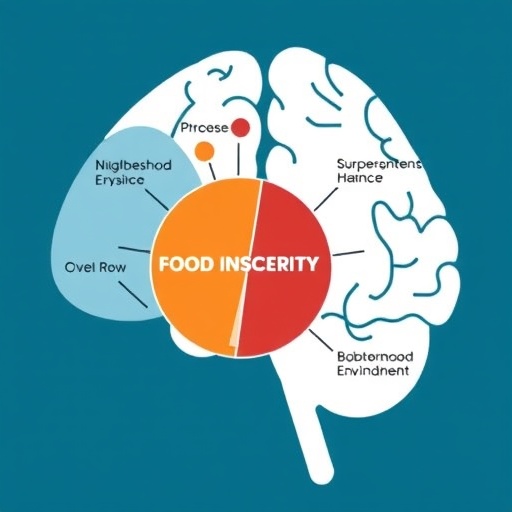A groundbreaking study published in Neurology® Clinical Practice has unveiled complex and somewhat paradoxical relationships between social determinants of health and stroke outcomes. Researchers explored how factors such as food insecurity, living in disadvantaged neighborhoods, and limited social support influence recovery and survival rates following intracerebral hemorrhage (ICH), a severe form of bleeding in the brain. With a vast cohort exceeding 480,000 individuals, this research breaks new ground in understanding the social dimensions affecting cerebrovascular disease prognosis.
Clinically, intracerebral hemorrhage represents a devastating form of stroke characterized by bleeding directly into the brain tissue, often leading to severe neurological impairments. Recovery trajectories and long-term outcomes after ICH are highly variable, traditionally linked to the severity of bleeding and medical interventions. However, this study shifts focus towards non-medical, socioeconomic factors — the so-called social determinants of health — and their intricate impact on patient recovery and survival post-ICH.
Leveraging extensive U.S. Census data alongside precise geospatial mapping of participants’ residences, researchers quantified several social variables, including food insecurity levels, neighborhood safety and environmental quality, social network strength, access to transportation, and various markers of civic engagement. These multidimensional social indicators were parsed into individual and community-level risk categories, examining their collective and discrete impacts on stroke recovery.
Remarkably, the study found that having at least one adverse social factor correlated strongly with worse functional outcomes following stroke. For example, food insecurity emerged as the most prevalent risk factor, affecting 87% of those identified with negative social determinants. This lack of reliable access to nutritious food was associated with a 61% higher risk of motor impairments post-stroke. Additionally, these individuals exhibited nearly double the probability of requiring invasive life-support measures such as feeding tubes and ventilators, and were 35% more likely to enter hospice care, underscoring the severity of their health challenges.
Comparing cohorts, individuals facing socioeconomic disadvantages had significantly higher rates of hospital readmission within 30 days post-ICH, with a readmission rate approaching 10% versus 6.2% among their more socially advantaged counterparts. These findings emphasize the tangible impact of social adversity on early recovery and the increased burden on healthcare systems resulting from these disparities.
In striking contrast to the negative effects on recovery metrics, the study revealed a surprising survival advantage for individuals grappling with adverse social determinants. At both 90 days and one year post-stroke, survival rates were notably higher among those facing social challenges: 78% versus 73% at 90 days and 62% versus 58% at one year. This unexpected finding fuels new discussions on the complex physiology and health care dynamics that may underlie survival outcomes.
Researchers hypothesize that the paradoxical increase in survival, despite worse neurological recovery, may reflect more aggressive use of life-sustaining interventions among individuals with socioeconomic disadvantages. The higher utilization of feeding and breathing tubes may prolong survival at the cost of quality of life or functional independence. Moreover, differential access to palliative care and variations in end-of-life decision-making processes across social groups may contribute substantially to these divergent outcomes.
The study’s authors emphasize that while these findings reveal intriguing associations, they do not establish causality between social determinants and stroke outcomes. Instead, the data underscore the urgent need for more nuanced research into how socioeconomic and environmental factors modulate brain repair, neuroplasticity, and resilience post-injury.
Importantly, this work also highlights substantial gaps in addressing the root causes of health inequities such as persistent poverty, systemic under-resourcing of vulnerable communities, and limited access to comprehensive post-stroke rehabilitation services. Such disparities not only exacerbate functional deficits but also impair long-term quality of life for stroke survivors.
From a clinical and public health perspective, these insights advocate for integrated approaches combining medical treatment with robust social support interventions. Policies aimed at alleviating food insecurity, improving neighborhood safety and environmental quality, and fostering social connectivity may profoundly shape the trajectory of stroke recovery and survivorship.
The study, though expansive, was limited by its inability to incorporate racial or ethnic data, which have been shown in other literature to significantly influence stroke outcomes. This limitation suggests future investigations should strive for more granular demographic analyses to tailor interventions to specific populations.
In conclusion, this comprehensive investigation into the social determinants of stroke outcomes illuminates the dual-edged nature of socioeconomic disadvantage. While linked to more severe functional impairments, these same factors seemingly confer unexpected survival benefits, spotlighting the intricate interplay between biology, social context, and healthcare delivery in shaping patient trajectories. Addressing these emergent complexities holds promise for developing more equitable, effective strategies in stroke care and rehabilitation.
Subject of Research: People
Article Title: [Not provided]
News Publication Date: June 18, 2025
Web References:
- https://www.neurology.org/journal/cpj
- https://aan.com/
- https://www.brainandlife.org/disorders/stroke
Keywords: Cardiovascular disorders, Food resources




